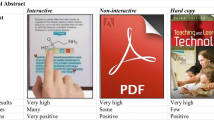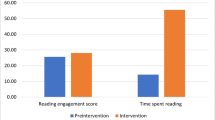Abstract
Today various types of tablet computers are used, including iPad and Android Tablets. These individual portable digital devices can be used as e-book readers to support mobile personalized learning. Though many studies have investigated e-books by targeting undergraduate students, yet less attention has been paid to children. Therefore, an Interactive E-book Learning System (IELS) was developed for elementary school students in this study. The interactive principles in multimedia learning were adopted to empower students’ personalized learning experiences with e-books. Meanwhile, in order to meet student’s learning needs, a group of in-service teachers were consulted for acquiring their domain expertise. Personalized learning functions, such as e-annotation and bookmarks, content searching, and learning process tracking, were designed to reinforce student learning. Two investigations were conducted for evaluation of the developed system. The first investigation was conducted with 166 elementary school students to evaluate the usability and functionality of the developed system and the feedback from the students. It was found that the usability and functionality of the developed system were well-suited for most of the students. The second investigation was to evaluate the learning effect of the developed system. The results showed that using an e-book or printed book made no significant difference to the students’ reading accuracy; however, the learning process tracking technique of IELS can provide detailed logs about the actual learning processes which can be used by the system to provide further assistance to individual learner. This study concludes that such a tailor-made e-book learning system could achieve a better personalized learning experience for elementary school students.







Similar content being viewed by others
References
Berg, S. A., Hoffmann, K., & Dawson, D. (2010). Not on the same page: Undergraduates’ information retrieval in electronic and print books. The Journal of Academic Librarianship, 36(6), 518–525.
Bierman, J., Ortega, L., & Rupp-Serrano, K. (2010). E-book usage in pure and applied sciences. Science & Technology Libraries, 29(1–2), 69–91.
Blewitt, P., Rump, K. M., Shealy, S. E., & Cook, S. A. (2009). Shared book reading: When and how questions affect young children’s word learning. Journal of Educational Psychology, 101(2), 294–304.
Bloice, M., Kreuzthaler, M., Simonic, K.-M., & Holzinger, A. (2010). On the paradigm shift of search on mobile devices: Some remarks on user habits. In G. Leitner, M. Hitz, & A. Holzinger (Eds.), Human–computer interaction in work & learning, life & leisure, lecture notes in computer science (Vol. 6389, pp. 493–496). Berlin: Springer.
Carver, R. P. (1977). Toward a theory of reading comprehension and rauding. Reading Research Quarterly, 13(1), 8–63.
Carver, R. P. (1983). Is reading rate constant or flexible? Reading Research Quarterly, 18(2), 190–215.
Carver, R. P. (1990). Reading rate: A review of research and theory. San Diego, CA: Academic Press.
Chappell, D. (2006). Introducing Windows presentation foundation. Retrieved January 18, 2011 from http://msdn.microsoft.com/en-us/library/aa663364.aspx.
Coyle, K. (2008). E-Reading. The Journal of Academic Librarianship, 34(2), 160–162.
de Jong, M. T. (2003). How well suited are electronic books to supporting literacy? Journal of Early Childhood Literacy, 3(2), 147–164.
de Jong, M. T., & Bus, A. G. (2002). Quality of book-reading matters for emergent readers: An experiment with the same book in a regular or electronic format. Journal of Educational Psychology, 94(1), 145–155.
Domagk, S., Schwartz, R. N., & Plass, J. L. (2010). Interactivity in multimedia learning: An integrated model. Computers in Human Behavior, 26(5), 1024–1033.
Duggan, G. B., & Payne, S. J. (2009). Text skimming: The process and effectiveness of foraging through text under time pressure. Journal of Experimental Psychology: Applied, 15(3), 228–242.
Dyson, M. C., & Haselgrove, M. (2000). The effects of reading speed and reading patterns on the understanding of text read from screen. Journal of Research in Reading, 23(2), 210–223.
Ecker, U. K. H., Lewandowsky, S., Oberauer, K., & Chee, A. E. H. (2010). The components of working memory updating: An experimental decomposition and individual differences. Journal of Experimental Psychology. Learning, Memory, and Cognition, 36(1), 170–189.
Fraser, C. A. (2007). Reading rate in L1 mandarin Chinese and L2 English across five reading tasks. The Modern Language Journal, 91(3), 372–394.
Gillett, J. W., & Temple, C. (1986). Understanding reading problems (2nd ed.). Boston: Little, Brown.
Grimshaw, S., Dungworth, N., McKnight, C., & Morris, A. (2007). Electronic books: Children’s reading and comprehension. British Journal of Educational Technology, 38(4), 583–599.
Hindman, A. H., Connor, C. M., Jewkes, A. M., & Morrison, F. J. (2008). Untangling the effects of shared book reading: Multiple factors and their associations with preschool literacy outcomes. Early Childhood Research Quarterly, 23(3), 330–350.
Holzinger, A. (2005). Usability engineering for software developers. Communications of the ACM, 48(1), 71–74.
Holzinger, A., Baernthaler, M., Pammer, W., Katz, H., Bjelic-Radisic, V., & Ziefle, M. (2011a). Investigating paper vs. screen in real-life hospital workflows: Performance contradicts perceived superiority of paper in the user experience. International Journal of Human-Computer Studies, 69(9), 563–570.
Holzinger, A., Searle, G., & Wernbacher, M. (2011b). The effect of previous exposure to technology on acceptance and its importance in usability and accessibility engineering. Universal Access in the Information Society, 10(3), 245–260.
Hourcade, J. P., Bederson, B. B., Druin, A., Rose, A., Farber, A., & Takayama, Y. (2003). The International Children’s Digital Library: Viewing digital books online. Interacting with Computers, 15(2), 151–167.
Huang, Y.-M., Chiu, P.-S., Liu, T.-C., & Chen, T.-S. (2011). The design and implementation of a meaningful learning-based evaluation method for ubiquitous learning. Computers & Education, 57(4), 2291–2302.
Huang, Y.-M., Huang, Y.-M., Huang, S.-H., & Lin, Y.-T. (2012). A ubiquitous English vocabulary learning system: Evidence of active/passive attitudes vs. usefulness/ease-of-use. Computers & Education, 58(1), 273–282.
Huang, Y. M., Lin, Y. T., & Cheng, S. C. (2009). An adaptive testing system for supporting versatile educational assessment. Computers & Education, 52(1), 53–67.
Huang, Y. M., & Wu, T. T. (2011). A systematic approach for learner group composition utilizing U-learning portfolio. Educational Technology & Society, 14(3), 102–117.
Johnson, M. S., Kress, R. A., & Pikulski, J. J. (1987). Informal reading inventories (2nd ed.). Newark, DE: International Reading Association.
Kerawalla, L., Pearce, D., Yuill, N., Luckin, R., & Harris, A. (2008). “I’m keeping those there, are you”? The role of a new user interface paradigm—Separate Control of Shared Space (SCOSS)—in the collaborative decision-making process. Computers & Education, 50(1), 193–206.
Korat, O. (2010). Reading electronic books as a support for vocabulary, story comprehension and word reading in kindergarten and first grade. Computers & Education, 55(1), 24–31.
Korat, O., & Shamir, A. (2007). Electronic books versus adult readers: Effects on children’s emergent literacy as a function of social class. Journal of Computer Assisted Learning, 23(3), 248–259.
Korat, O., & Shamir, A. (2008). The educational electronic book as a tool for supporting children’s emergent literacy in low versus middle SES groups. Computers & Education, 50(1), 110–124.
Lam, P., Lam, S. L., Lam, J., & McNaught, C. (2009). Usability and usefulness of eBooks on PPCs: How students’ opinions vary over time. Australasian Journal of Educational Technology, 25(1), 30–44.
Larson, L. C. (2009). Reader response meets new literacies: Empowering readers in online learning communities. Reading Teacher, 62(8), 638–648.
Lin, Y. T., Huang, Y. M., & Cheng, S. C. (2010). An automatic group composition system for composing collaborative learning groups using enhanced particle swarm optimization. Computers & Education, 55(4), 1483–1493.
Lund, A. M. (2001). Measuring usability with the USE questionnaire. Retrieved January 19, 2011 from http://www.stcsig.org/usability/newsletter/0110_measuring_with_use.html.
McLay, B. (2007). Reading rate: Research versus teaching. Retrieved March 15, 2011 from http://www.learningassistance.com/2007/november/printables/readingrateprint.html.
Ministry of Education, Republic of China. (2000). A survey report of Chinese common words for elementary school. Retrieved April 25, 2011 from http://www.edu.tw/files/site_content/M0001/primary/shindex.htm?open.
Ministry of Education, Republic of China. (2010). Overview of the intelligent Taiwan—manpower cultivation project. Retrieved April 25, 2011 from http://english.moe.gov.tw/ct.asp?xItem=10164&ctNode=784&mp=1.
Mol, S. E., Bus, A. G., & de Jong, M. T. (2009). Interactive book reading in early education: A tool to stimulate print knowledge as well as oral language. Review of Educational Research, 79(2), 979–1007.
Mol, S. E., Bus, A. G., de Jong, M. T., & Smeets, D. J. H. (2008). Added value of dialogic parent–child book readings: A meta-analysis. Early Education & Development, 19(1), 7–26.
MSDN. (2010). FlowDocumentReader.Find Method. Retrieved January 24, 2011, from http://msdn.microsoft.com/en-us/library/system.windows.controls.flowdocumentreader.find(v=VS.90).aspx.
MSDN. (2011). Flow document overview. Retrieved January 24, 2011 from http://msdn.microsoft.com/en-us/library/aa970909.aspx.
Nation, K., & Cocksey, J. (2009). The relationship between knowing a word and reading it aloud in children’s word reading development. Journal of Experimental Child Psychology, 103(3), 296–308.
Nielsen, J. (2006). F-shaped pattern for reading web content. Retrieved November 5, 2010 from http://www.useit.com/alertbox/reading_pattern.html.
Pattuelli, M. C., & Rabina, D. (2010). Forms, effects, function: LIS students’ attitudes towards portable e-book readers. Aslib Proceedings, 62(3), 228–244.
Qayyum, M. A. (2008). Capturing the online academic reading process. Information Processing and Management, 44(2), 581–595.
Rasinski, T. V. (1999). Exploring a method for estimating independent, instructional, and frustration reading rates. Reading Psychology, 20(1), 61–69.
Rasinski, T. V. (2000). Speed does matter in reading. Reading Teacher, 54(2), 146–151.
Revelle, G., Druin, A., Platner, M., Bederson, B., Hourcade, J. P., & Sherman, L. (2002). A visual search tool for early elementary science students. Journal of Science Education and Technology, 11(1), 49–57.
Segal-Drori, O., Korat, O., Shamir, A., & Klein, P. S. (2010). Reading electronic and printed books with and without adult instruction: Effects on emergent reading. Reading and Writing, 23(8), 913–930.
Shamir, A., Korat, O., & Barbi, N. (2008). The effects of CD-ROM storybook reading on low SES kindergarteners’ emergent literacy as a function of learning context. Computers & Education, 51(1), 354–367.
Shepperd, J. A., Grace, J. L., & Koch, E. J. (2008). Evaluating the electronic textbook: Is it time to dispense with the paper text? Teaching of Psychology, 35(1), 2–5.
Spink, A., Danby, S., Mallan, K., & Butler, C. (2010). Exploring young children’s web searching and technoliteracy. Journal of Documentation, 66(2), 191–206.
Straker, L., Pollock, C., & Maslen, B. (2009). Principles for the wise use of computers by children. Ergonomics, 52(11), 1386–1401.
Stroud, J. B., & Henderson, M. (1943). Rate of reading and learning by reading. Journal of Educational Psychology, 34(4), 193–205.
Swanson, H. L., & Howell, M. (2001). Working memory, short-term memory, and speech rate as predictors of children’s reading performance at different ages. Journal of Educational Psychology, 93(4), 720–734.
TCA. (2009). About e-reading. Retrieved April 25, 2011 from http://ereading.computex.biz/SinglePage.aspx?index=213.
Tung, F. W., & Deng, Y. S. (2006). Designing social presence in e-learning environments: Testing the effect of interactivity on children. Interactive Learning Environments, 14(3), 251–264.
U.S. Department of Education. (2010). Transforming American education learning powered by technology. Retrieved November 15, 2010 from http://www.ed.gov/sites/default/files/netp2010.pdf.
Woody, W. D., Daniel, D. B., & Baker, C. A. (2010). E-books or textbooks: Students prefer textbooks. Computers & Education, 55(3), 945–948.
Wu, T.-T., Huang, Y.-M., Chao, H.-C., & Park, J. H. (in press, uncorrected proof). Personlized English reading sequencing based on learning portfolio analysis. Information Sciences. doi:10.1016/j.ins.2011.07.021.
Yuill, N., Pearce, D., Kerawalla, L., Harris, A., & Luckin, R. (2009). How technology for comprehension training can support conversation towards the joint construction of meaning. Journal of Research in Reading, 32(1), 109–125.
Acknowledgments
This work was supported by the National Science Council (NSC) and Ministry of Education, Taiwan, ROC, under Contracts No. NSC 99-2631-S-011-002, NSC 99-2631-S-006-001, NSC 100-2631-S-006-002, NSC 100-2511-S-006-015-MY3, NSC 100-2511-S-006-014-MY3 and the MOE 99-ICT innovative school plan.
Author information
Authors and Affiliations
Corresponding author
Rights and permissions
About this article
Cite this article
Huang, YM., Liang, TH., Su, YN. et al. Empowering personalized learning with an interactive e-book learning system for elementary school students. Education Tech Research Dev 60, 703–722 (2012). https://doi.org/10.1007/s11423-012-9237-6
Published:
Issue Date:
DOI: https://doi.org/10.1007/s11423-012-9237-6




